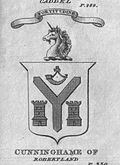- David Cunninghame of Robertland
-
Sir David Cunninghame of Robertland, in Ayrshire, was Master of Work to the Crown of Scotland from 1602 to 1607.
Involved in the murder of the Earl of Eglinton in 1585, Cunninghame spent some time in exile at the royal court of Denmark, and the Danish government wrote to James VI of Scotland to reconcile him with Eglinton's heirs.[1] He was rehabilitated in 1589, when James VI himself travelled there to meet and marry Anne of Denmark. A Danish journal records that on 27 November 1589, the Danish ladies-in-waiting asked Bishop Jens Nilssøn to discuss the case with the Scottish chancellor. The ladies, bishop and chancellor then had an audience with James VI at the Old Bishop's Palace in Oslo. James granted a pardon.[2] On arrival in Scotland he was appointed as 'sewer' to Queen Anne, a courtier who attended to the royal person at mealtimes, and a role once occupied by James Hamilton of Finnart for James V.[3]
He was appointed Master of Works after the death of William Schaw in 1602. He may have been an architect, and followed the court of King James to England, having first been knighted in 1604, and then made Surveyor of the King's Works in England between 1604 and 1606.[4] Cunninghame is sometimes confused with a younger namesake cousin, David Cunningham, 1st Baronet of Auchinhervie.[5]
Robertland had three sons. One was a gentleman of the chamber to Count Maurice in the Netherlands. He was arrested in Hull while bringing muskets for James VI in August 1599.[6]See also
- Castle and Barony of Robertland
References
- ^ Thomas Riis, Should Auld Acquaintance be Forgot, vol. ii, (1988), 58
- ^ David Stevenson , Scotland's Last Royal Wedding,(1997), p.94-95
- ^ Papers relative to the marriage of James VI, Bannatyne Club (1828), 28
- ^ McKean, Charles (2001). The Scottish Chateau. Sutton Publishing. ISBN 0-7509-2323-7. p.158.
- ^ John Summerson, in History of the King's Works, ed. HM Colvin.
- ^ Calendar of State Papers Scotland, vol. 13 part 1, HMSO (1969), 541.
Preceded by
William SchawMaster of Work to the Crown of Scotland
1602–1607Succeeded by
Sir James MurrayCategories:- Scottish architects
- Masters of Work to the Crown of Scotland
- Scottish people stubs
Wikimedia Foundation. 2010.

